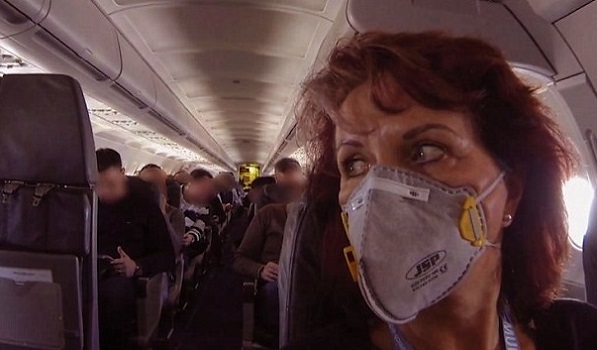Nikhil Prasad Fact checked by:Thailand Medical News Team Jul 01, 2025 5 months, 3 weeks, 2 days, 8 hours, 8 minutes ago
Thailand Health News:
Alarming Health Risks Tied to Cabin Air on Jet Flights
Millions of passengers board commercial jets every year, unaware that the air they breathe mid-flight may be contaminated with toxic chemicals capable of causing long-term neurological harm. This
Thailand Health News report highlights findings from a groundbreaking study by Professor Jeremy J. Ramsden from the Department of Biomedical Research at the University of Buckingham, UK, and the Sustainable Aviation Unit at Collegium Basilea in Switzerland. The study examines the realities behind “Aerotoxic Syndrome,” a growing concern for airline staff and frequent flyers exposed to chemicals in cabin air.
 Aerotoxic Syndrome and How Flying Could Be Slowly Poisoning Frequent Flyers
Aerotoxic Syndrome and How Flying Could Be Slowly Poisoning Frequent Flyers
Aerotoxic Syndrome refers to a group of symptoms—including headaches, dizziness, memory issues, eye and throat irritation, and even long-term neurological damage—that appear after flying. These symptoms are not random. Surveys indicate that up to 50% of frequent flyers experience some form of discomfort or illness after flights, and the culprit may lie in what’s known as “bleed air”—air drawn from jet engines that is used to pressurize and ventilate cabins. This air can become contaminated with engine oil byproducts and toxic substances like tricresyl phosphate (TCP) and carbon monoxide (CO), both known neurotoxins.
Evidence Shows Dangerous Chemicals Present on Most Flights
The study analyzed in-flight air samples and found measurable levels of neurotoxic substances, including:
-Tricresyl phosphate (TCP): Found in jet engine oil, this substance can damage nerves and brain function. Even its most toxic form—tri-ortho-cresyl phosphate (ToCP)—was detected.
-Carbon monoxide (CO): Found at levels significantly above normal, CO exposure is particularly hazardous due to its ability to bind with blood hemoglobin, cutting off oxygen supply to organs.
-Toluene and TBP (tributyl phosphate): Additional chemicals with known health risks, also present in many flights.
-Ultrafine particles (UFPs): Tiny metallic and ceramic particles likely from turbine blade coatings were also detected in cabin air, capable of triggering oxidative stress and inflammation.
The effects are made worse due to the unique environment of aircraft cabins: low humidity, lower oxygen levels, and prolonged confinement. These factors amplify the toxicity of even low concentrations of harmful substances.
Who Is Most at Risk and Why Recovery Can Be Difficult
Flight crew and frequent flyers are most susceptible. Aircrew often suffer severe symptoms due to chronic exposure, with some even forced to end their careers. In one extensively documented case, a pilot who had never been
in a visible “fume event” still developed fatal neurological damage, revealing just how subtle and cumulative the poisoning can be.
A crucial finding of the study is the role of individual susceptibility. Genetic differences in metabolism and detoxification rates mean some people may be more prone to injury even at low levels of exposure. Some substances like ToCP can cause irreversible damage, and standard workplace safety thresholds used by regulators do not apply well to airplane conditions or vulnerable populations.
What Can Be Done to Reduce the Health Risks
Professor Ramsden suggests several urgent measures:
-Retrofitting aircraft to eliminate bleed air systems, as seen in the Boeing 787
-Installing onboard sensors to detect CO and toxic chemicals
-Using filters and masks for passengers and aircrew during suspected contamination
-Creating standardized medical tests for susceptibility to Aerotoxic Syndrome
-Improving airline maintenance and cabin air quality monitoring practices
As passenger traffic continues to grow, Aerotoxic Syndrome is likely to become a major public health issue unless these recommendations are taken seriously by governments and airlines alike.
Conclusion
Aerotoxic Syndrome is not just a theory—it is a real and growing health concern tied to chemical exposure in aircraft cabin air. The evidence shows that even low-level, chronic exposure can result in cognitive damage, fatigue, and potentially irreversible neurological harm. Protecting the health of passengers and flight crews will require changes in aircraft design, stronger regulation, improved maintenance, and greater public awareness. Without these changes, the skies could continue to pose hidden dangers to millions.
The study findings were published in the peer reviewed journal: Toxics.
https://www.mdpi.com/2305-6304/13/6/420
For the latest
Thailand Health News, keep on logging to
Thailand Medical News
Read Also:
https://www.thailandmedical.news/news/spanish-study-finds-that-eating-peanuts-slows-aging-in-youth-by-protecting-dna-telomeres
https://www.thailandmedical.news/news/how-dairy-consumption-affects-the-gut-microbiome
https://www.thailandmedical.news/news/betalains-for-better-health
https://www.thailandmedical.news/articles/health-news
